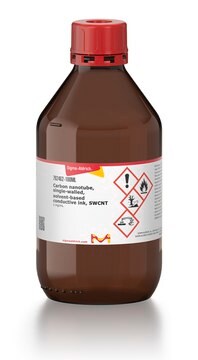791903
Conductive silver printing ink, resistivity 30 - 35 μΩ-cm
Sinônimo(s):
Dyesol® DYAG350 conductive silver ink, Screen printable silver paste
About This Item
Produtos recomendados
descrição
volume resistivity 30 - 35 μΩ-cm at a 180°C cure temperature
forma
paste (white)
composição
Solids content, 65-75%
viscosidade
6000-9000 mPa.s (at shear rate of 10 sec-1 at 25°C)
Descrição geral
Aplicação
This Conductive Silver Printing Ink is comprised of a mixture of pure silver particles and organometallic silver compound in an organic medium. When printed on polyester (PET or PEN) films and then cured at 150 - 180°C, the particles consolidate to form a chemically-welded, continuous silver track to yield low bulk resistivity.
Informações legais
Palavra indicadora
Warning
Frases de perigo
Declarações de precaução
Classificações de perigo
Aquatic Acute 1 - Aquatic Chronic 1 - Eye Irrit. 2 - Skin Irrit. 2
Código de classe de armazenamento
10 - Combustible liquids
Classe de risco de água (WGK)
WGK 3
Ponto de fulgor (°F)
174.2 °F
Ponto de fulgor (°C)
79 °C
Escolha uma das versões mais recentes:
Certificados de análise (COA)
Não está vendo a versão correta?
Se precisar de uma versão específica, você pode procurar um certificado específico pelo número do lote ou da remessa.
Já possui este produto?
Encontre a documentação dos produtos que você adquiriu recentemente na biblioteca de documentos.
Os clientes também visualizaram
Artigos
The ability to pattern conductive electrodes is technologically relevant for several applications, including photovolatics, displays, sensors, and biomedical devices.
Dr. Chan and researchers highlight flexible transistors are the building blocks of next-generation soft electronics. Among all the reported material systems that can be fabricated by researchers, such as circuits, biosensors, stretchable displays, and others,1–5 small molecular weight organic semiconductors are among the most promising candidates for flexible transistor applications. For these small molecular weight organic semiconductors, the semiconductor forming the conductive channel dominates the device performance.
Dye-sensitized solar cells (DSCs) are 3rd generation solar cells combining the promise of high efficiency with low production costs.
Professor Tokito and Professor Takeda share their new materials, device architecture design principles, and performance optimization protocols for printed and solution-processed, low-cost, highly flexible, organic electronic devices.
Nossa equipe de cientistas tem experiência em todas as áreas de pesquisa, incluindo Life Sciences, ciência de materiais, síntese química, cromatografia, química analítica e muitas outras.
Entre em contato com a assistência técnica


